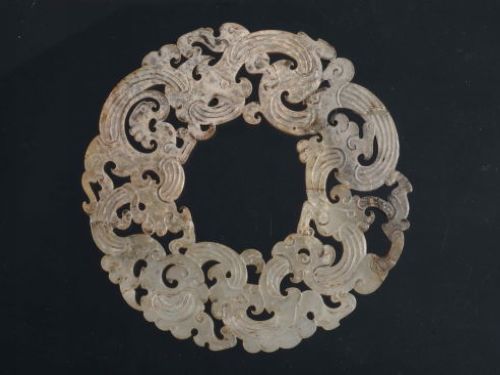Tomb of the Tomb of the Cao Nvwa House of the Changsha Museum
 The jade culture centered on jade has deeply influenced the ideas of the ancient Chinese and became an indispensable part of Chinese culture. In the course of development in China for thousands of years, jade articles have undergone many changes. In general, they have turned from religious ones to secular ones. In particular, the changes in ornamentation and form have all had obvious characteristics of the times and people have become regular people. One of the jewellery jades worn was the most outstanding among the Jade articles of the Western Han Dynasty.
The jade culture centered on jade has deeply influenced the ideas of the ancient Chinese and became an indispensable part of Chinese culture. In the course of development in China for thousands of years, jade articles have undergone many changes. In general, they have turned from religious ones to secular ones. In particular, the changes in ornamentation and form have all had obvious characteristics of the times and people have become regular people. One of the jewellery jades worn was the most outstanding among the Jade articles of the Western Han Dynasty. In the warehouse of the Changsha City Museum, there are thousands of jade articles collected from the Warring States Period to the late Qing Dynasty and the early years of the Republic of China. Among them, the Warring States and the Han dynasty were the most exquisite ones. Among these, it was considered a masterpiece of rarity. It was December 1974. To the Western Han Dynasty jade ware unearthed at No. 1 Graced Hill of Xianjiahu, Changsha in January 1975, the tomb was unearthed in the tomb with the “Ancestors of the Caoâ€, the two sides of the agate and the “Ancestral Hall†and the Agate and India. It was named "Tomb of Cao".
The Tomb of the Cao Nunnery was built on the top of the steep mountain and is a mountainous tomb. It is a large-scale pit with a tombstone and a wooden stork. A yellow bow was found inside the grave. The tombs are slope-type and north of the west wall of the tomb pit. Near the mouth of the grave, there are two relatively empty holes in the north and south, which are the “even people†marks. The crater pit is a rock pit, and the upper mouth is destroyed. The existing tomb mouth is 12.8 meters long from east to west and 10 meters wide from north to south. The bottom of the pit is 11.6 meters long, 9.5 meters wide from north to south, and 2-2.8 meters deep. The tomb was stolen in the early years. Two burglars were found on the north side of the tomb. One of the burglars discovered the remains of the porcelain bowl in the Tang Dynasty. It can be seen that some people in the Tang Dynasty had already stolen the tomb.
Although the tomb of the Cao Nu Nuo was stolen in the early days, in the 1970s archaeologists unearthed a large number of artifacts during excavations. According to statistics, there were more than 300 pieces, and nearly 100 were preserved. There are mainly metalware, jade tools, lacquer woodware and clay-ceramics, especially the most precious jade tools, including three seals, open-cut phoenix phoenix rings, chicken hearts, white jade, jade, jade and a large number of jade. Such as 璧 璧 , , , , , 这些 这些 这些 这些 这些 这些 这些 这些 这些 这些 这些 这些 这些 这些 这些 这些.
The excavation of so many exquisite jade articles from the tomb of the Cao Nu Nui tomb shows that the tomb owner’s status before his death is very noble. About the tomb's age and the identity of the owner of the tomb, there are many scholars to study, of which there are many different opinions about the tombs. According to different angles of study and citations of materials, scholars had two versions of the early and middle Western Han Dynasty on this tomb era, but most people think that it was an early Western Han tomb, and it should be after the beginning of Han Dynasty when Wu surnamed Changsha. Regarding the identity of Cao Nunnery, Li Shisheng of the Changsha Municipal Institute of Cultural Relics and Archaeology mentioned it in his related papers, saying: “Compared with this, Cao Nu Nuo is more likely to be a member of the Cao Sen Family.†Such a prominent birth and husband The noble status of the family created the use of jade, lacquerware, and bronze wares that were used to make funerary objects after their death. This point, even the tomb of Mrs. Xin Ching buried in Mawangdui, Changsha, is far from reachable.
The exquisitely exquisite jade articles unearthed from the tomb of Cao Nunneng in the steep cliff of Changsha not only witnessed the luxury of the early Changsha in the Western Han Dynasty, but more importantly, it revealed the development of the Jade Warriors in the Western Han Dynasty, because these jade ornaments were shaped or shaped. All belong to the typical device of the Western Han Dynasty.
From the development of human society to today, with the development of the jewellery and jade industry, jade jewelry has entered the homes of ordinary people and decorated people's lives with its special charm. It plays an increasingly important role in social material civilization and spiritual civilization. .
Long Shorts,A Line Shorts,Cotton Shorts,Summer Shorts,Sequin Shorts
Fan Fashion Garments CO,LTD , https://www.viatwinkle.com